仁爱科普版(2024)七年级上册 Unit 2 Meet My Family 第5课时 Grammar in use课件(共22张PPT)
文档属性
| 名称 | 仁爱科普版(2024)七年级上册 Unit 2 Meet My Family 第5课时 Grammar in use课件(共22张PPT) | 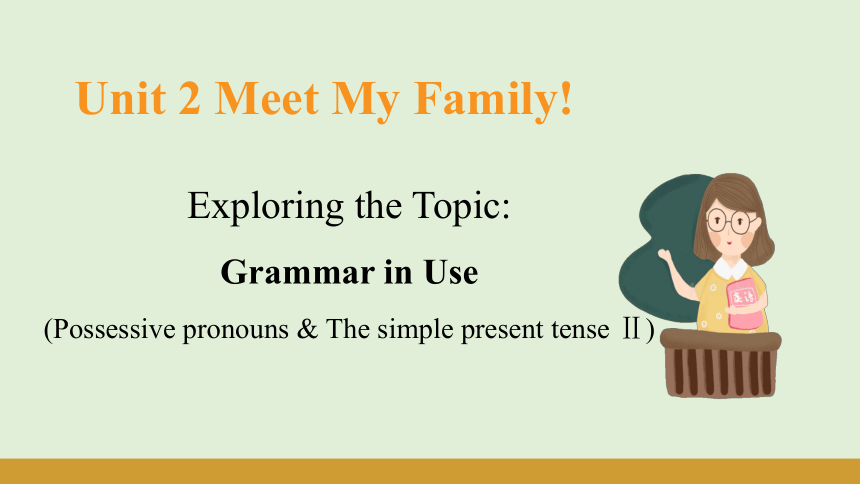 | |
| 格式 | pptx | ||
| 文件大小 | 22.2MB | ||
| 资源类型 | 教案 | ||
| 版本资源 | 仁爱科普版 | ||
| 科目 | 英语 | ||
| 更新时间 | 2024-10-12 21:07:37 | ||
图片预览

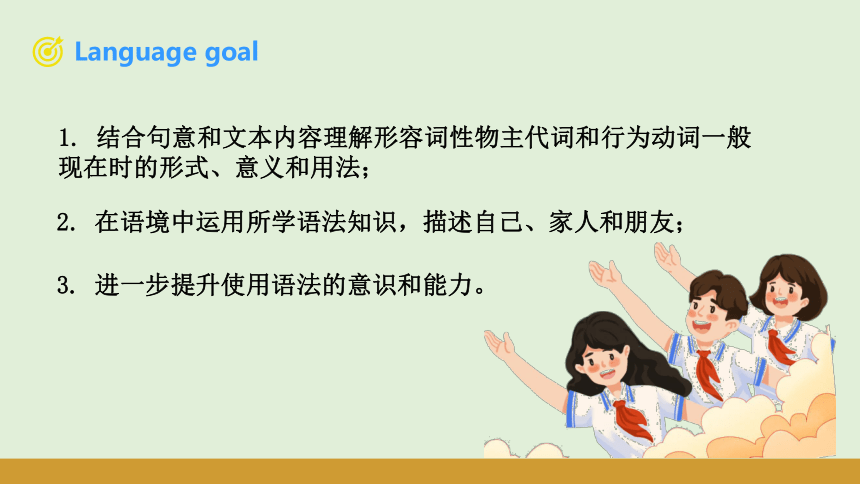

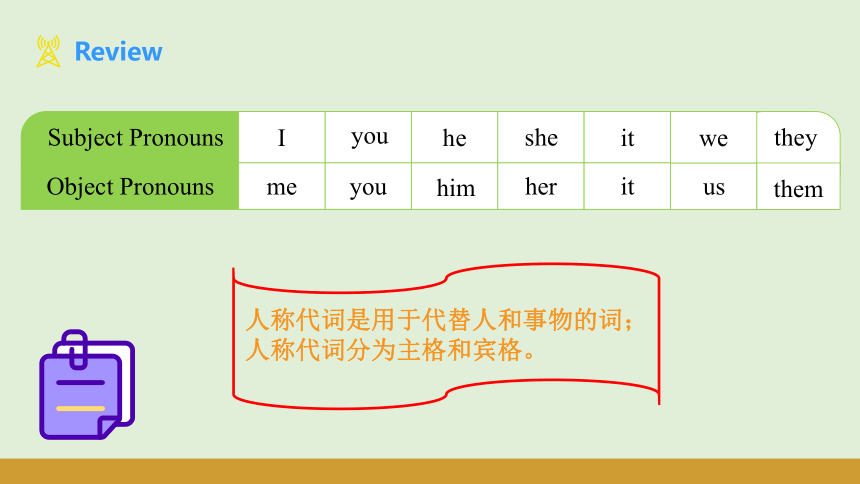
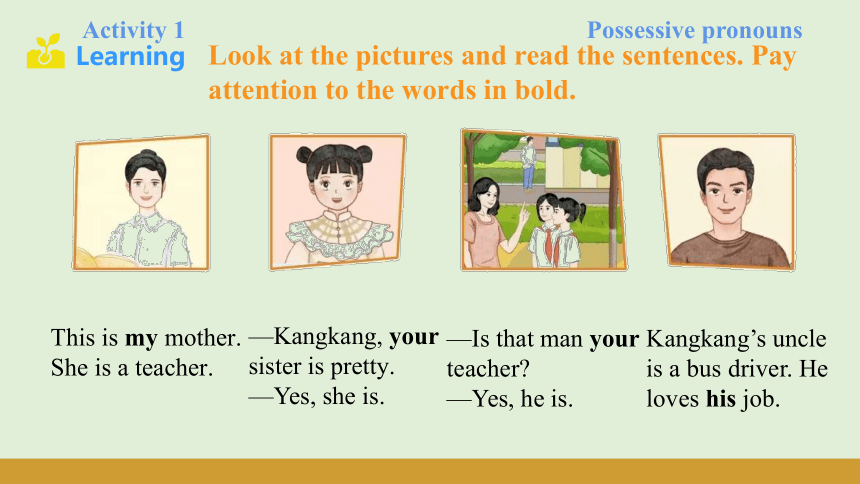
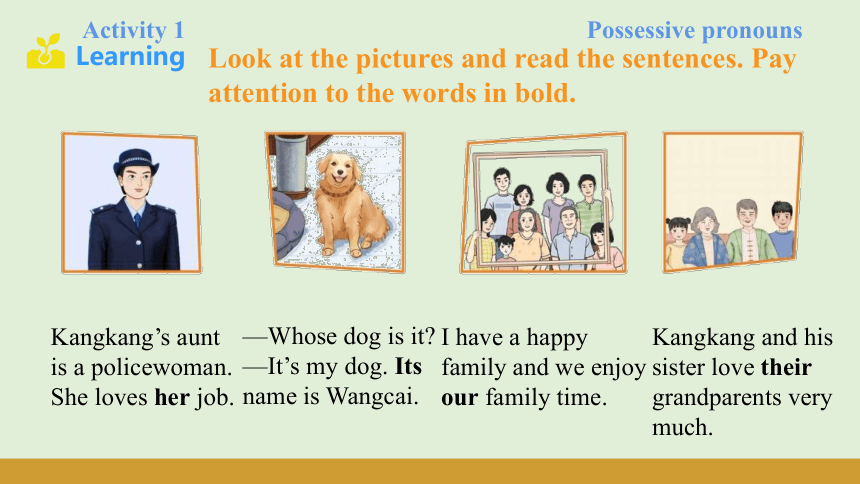
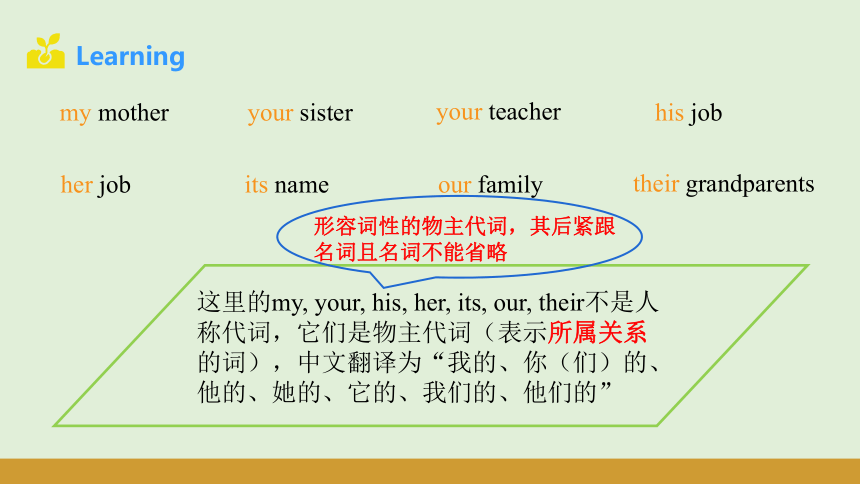
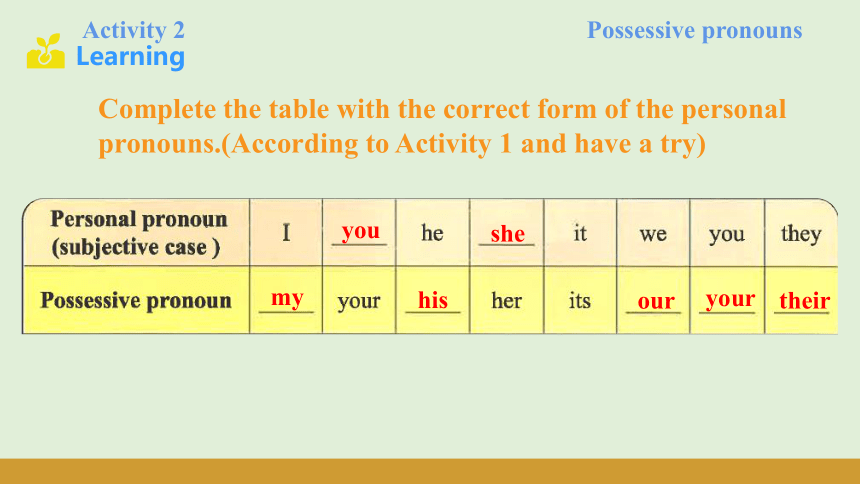
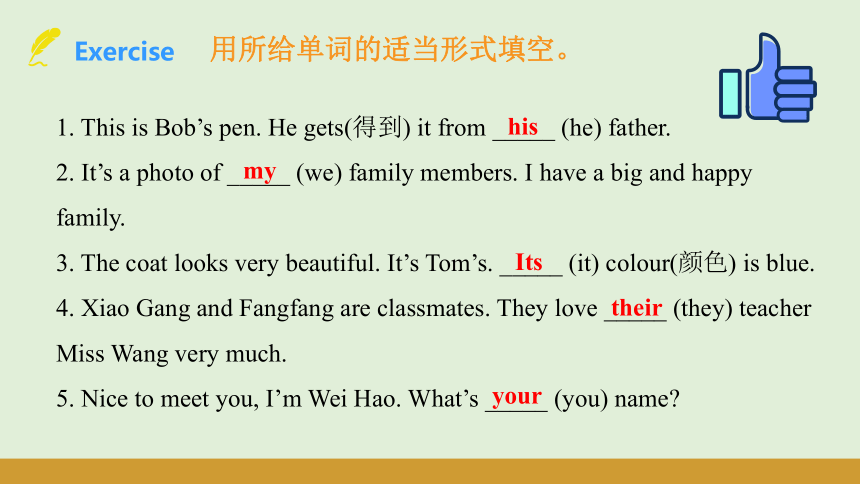
文档简介
(共22张PPT)
Unit 2 Meet My Family!
Exploring the Topic:
Grammar in Use
(Possessive pronouns & The simple present tense Ⅱ)
3. 进一步提升使用语法的意识和能力。
1. 结合句意和文本内容理解形容词性物主代词和行为动词一般现在时的形式、意义和用法;
2. 在语境中运用所学语法知识,描述自己、家人和朋友;
Kangkang’s family
人称代词
Subject Pronouns
Object Pronouns
you
he
it
her
it
they
we
I
me
you
him
she
us
them
人称代词是用于代替人和事物的词;
人称代词分为主格和宾格。
Activity 1
This is my mother.
She is a teacher.
—Kangkang, your sister is pretty.
—Yes, she is.
—Is that man your teacher
—Yes, he is.
Kangkang’s uncle is a bus driver. He loves his job.
Look at the pictures and read the sentences. Pay attention to the words in bold.
Possessive pronouns
Activity 1
Possessive pronouns
Look at the pictures and read the sentences. Pay attention to the words in bold.
Kangkang’s aunt is a policewoman.
She loves her job.
—Whose dog is it
—It’s my dog. Its name is Wangcai.
I have a happy family and we enjoy our family time.
Kangkang and his sister love their grandparents very much.
my mother
your sister
your teacher
his job
her job
its name
our family
their grandparents
这里的my, your, his, her, its, our, their不是人称代词,它们是物主代词(表示所属关系的词),中文翻译为“我的、你(们)的、他的、她的、它的、我们的、他们的”
形容词性的物主代词,其后紧跟
名词且名词不能省略
Activity 2
Complete the table with the correct form of the personal pronouns.(According to Activity 1 and have a try)
Possessive pronouns
my
his
our
your
their
you
she
1. This is Bob’s pen. He gets(得到) it from _____ (he) father.
2. It’s a photo of _____ (we) family members. I have a big and happy family.
3. The coat looks very beautiful. It’s Tom’s. _____ (it) colour(颜色) is blue.
4. Xiao Gang and Fangfang are classmates. They love _____ (they) teacher Miss Wang very much.
5. Nice to meet you, I’m Wei Hao. What’s _____ (you) name
用所给单词的适当形式填空。
his
my
Its
their
your
Activity 3
Read the text and fill in the blanks with correct pronouns.
Possessive pronouns
their
His
his
Her
Its
1. —Whose dog is it —It’s my dog. —这是谁的狗?—这是我的狗。
whose意为“谁的”,表示所属关系,在句中既可单独使用,也可与名词连用;其答语可以用“形容词性物主代词+名词”来回答。如:
— Whose T-shirt is this = Whose is this T-shirt —It’s her T-shirt.
2. a bus driver 一名公交车司机
enjoy our family time 享受我们的家庭时光
riding his bike 骑他的自行车
Activity 1
The simple present tense (Ⅱ)
Pair work. Read the conversation. Pay attention to the words in bold.
Hello! My name is Li Mei. What’s your name
Hi! I am Li Xiang. Are you in Class Three
Yes, I am. We are classmates.
No, he isn’t. He is in Class One.
Is that boy our classmate, too
还记得“我们”吗?
(1)概念:一般现在时表示现在的状态,也表示某种经常性或习惯性的动作,还可表示人物的性格、爱好和能力。
eg. I often speak Chinese. 我经常说汉语。(表示经常性)
I get up at 6:00 every day. 我每天6点起床。(表示习惯性)
He speaks English. 他说英语。(表示能力)
(2)构成及形式:
①陈述句。若谓语动词是be动词,则根据主语的人称和数,选用am,is,are(口诀: I 用am, you 用are,单数is,复数are)。
eg. I am in Class 8, Grade 7. He is our English teacher.
若谓语动词是实义动词(行为动词),一般现在时的陈述句结构为:主语+实义动词(原形或第三人称单数形式)+其他。
eg. You like math. Tom speaks English.
一般现在时
(2)构成及形式:
②否定句。当谓语动词是be动词时,在be动词后面加not, 即主语+be动词+not+其他。 eg. Nick is not a teacher.
当谓语动词是实义动词时,在动词前面加助动词don’t/doesn’t,动词还原为原形。即主语+don’t/doesn’t+实义动词+其他。(主语为第三人称单数时,助动词用doesn’t,其余用don’t。)
eg. They don’t live in China. Linda doesn’t have a pen pal.
③ 一般疑问句。当谓语动词是be动词时,一般疑问句的结构为:Be(am,is,are) + 主语+表语。其肯定回答为:Yes, 主语+am/is/are; 否定回答为:No, 主语+am/is/are+not。
(2)构成及形式:
eg. —Is he a student —Yes, he is. / No, he isn’t.
当谓语动词是实义动词时,在肯定句句首加助动词do/does, 即Do/Does+主语+实义动词+其他。其肯定回答为:Yes, 主语(人称代词主格)+do/does; 否定回答为:No, 主语(人称代词主格)+don’t/doesn’t.
注:第一人称、第二人称和所有人称的复数都用do,第三人称单数用does。
eg. Does your sister like blue
补充:特殊疑问句结构为:特殊疑问词+一般疑问句。
eg. Who is the letter from Where does he live
Activity 2
The simple present tense (Ⅱ)
Complete the tables and learn how to use the simple present tense.
likes
Does
doesn’t
doesn’t like
do
( )1. —Are Lucy and Kangkang in different grade —Yes. But they often ____ games together.
A. plays B. playing C. play
( )2. —____ Jack speak English —No, he ____ .
A. Is; isn’t B. Does; doesn’t C. Do; don’t
( )3. —Liu Hong is a nice girl. —Yes. And ____ often helps ____ at school.
A. she; me B. she; my C. her; me
( )4. —Can you help me move(移动) the desk —____ .
A. It’s right. B. You’re welcome. C. That’s OK.
选择填空
C
B
A
C
Activity 3
Group work. Read the example and complete the
table, and then make short conversations.
The simple present tense (Ⅱ)
Activity 3
The simple present tense (Ⅱ)
Have a try!
Does she speak Chinese
No, she doesn’t. She speaks English.
What does she like
She likes Chinese a lot.
She wants(想要) to visit the Great Wall.
1. 通过复习人称代词,学会了形容词性的物主代词及其用法
2. 复习了一般现在时中be动词的用法和句型结构;进一步学习了一般现在时中动词是实义动词的句型结构及用法:
陈述句:主语+be(am/is/are)/主语+实义动词(原形或第三人称单数形式)+其他
否定句:主语+be动词+not+其他 / 主语+don’t/doesn’t+实义动词+其他
一般疑问句及其简单回答
1. Read the text in Activity 3 on page 28 three times.
2. Review other lessons to find out the grammar points we learnt today.
Unit 2 Meet My Family!
Exploring the Topic:
Grammar in Use
(Possessive pronouns & The simple present tense Ⅱ)
3. 进一步提升使用语法的意识和能力。
1. 结合句意和文本内容理解形容词性物主代词和行为动词一般现在时的形式、意义和用法;
2. 在语境中运用所学语法知识,描述自己、家人和朋友;
Kangkang’s family
人称代词
Subject Pronouns
Object Pronouns
you
he
it
her
it
they
we
I
me
you
him
she
us
them
人称代词是用于代替人和事物的词;
人称代词分为主格和宾格。
Activity 1
This is my mother.
She is a teacher.
—Kangkang, your sister is pretty.
—Yes, she is.
—Is that man your teacher
—Yes, he is.
Kangkang’s uncle is a bus driver. He loves his job.
Look at the pictures and read the sentences. Pay attention to the words in bold.
Possessive pronouns
Activity 1
Possessive pronouns
Look at the pictures and read the sentences. Pay attention to the words in bold.
Kangkang’s aunt is a policewoman.
She loves her job.
—Whose dog is it
—It’s my dog. Its name is Wangcai.
I have a happy family and we enjoy our family time.
Kangkang and his sister love their grandparents very much.
my mother
your sister
your teacher
his job
her job
its name
our family
their grandparents
这里的my, your, his, her, its, our, their不是人称代词,它们是物主代词(表示所属关系的词),中文翻译为“我的、你(们)的、他的、她的、它的、我们的、他们的”
形容词性的物主代词,其后紧跟
名词且名词不能省略
Activity 2
Complete the table with the correct form of the personal pronouns.(According to Activity 1 and have a try)
Possessive pronouns
my
his
our
your
their
you
she
1. This is Bob’s pen. He gets(得到) it from _____ (he) father.
2. It’s a photo of _____ (we) family members. I have a big and happy family.
3. The coat looks very beautiful. It’s Tom’s. _____ (it) colour(颜色) is blue.
4. Xiao Gang and Fangfang are classmates. They love _____ (they) teacher Miss Wang very much.
5. Nice to meet you, I’m Wei Hao. What’s _____ (you) name
用所给单词的适当形式填空。
his
my
Its
their
your
Activity 3
Read the text and fill in the blanks with correct pronouns.
Possessive pronouns
their
His
his
Her
Its
1. —Whose dog is it —It’s my dog. —这是谁的狗?—这是我的狗。
whose意为“谁的”,表示所属关系,在句中既可单独使用,也可与名词连用;其答语可以用“形容词性物主代词+名词”来回答。如:
— Whose T-shirt is this = Whose is this T-shirt —It’s her T-shirt.
2. a bus driver 一名公交车司机
enjoy our family time 享受我们的家庭时光
riding his bike 骑他的自行车
Activity 1
The simple present tense (Ⅱ)
Pair work. Read the conversation. Pay attention to the words in bold.
Hello! My name is Li Mei. What’s your name
Hi! I am Li Xiang. Are you in Class Three
Yes, I am. We are classmates.
No, he isn’t. He is in Class One.
Is that boy our classmate, too
还记得“我们”吗?
(1)概念:一般现在时表示现在的状态,也表示某种经常性或习惯性的动作,还可表示人物的性格、爱好和能力。
eg. I often speak Chinese. 我经常说汉语。(表示经常性)
I get up at 6:00 every day. 我每天6点起床。(表示习惯性)
He speaks English. 他说英语。(表示能力)
(2)构成及形式:
①陈述句。若谓语动词是be动词,则根据主语的人称和数,选用am,is,are(口诀: I 用am, you 用are,单数is,复数are)。
eg. I am in Class 8, Grade 7. He is our English teacher.
若谓语动词是实义动词(行为动词),一般现在时的陈述句结构为:主语+实义动词(原形或第三人称单数形式)+其他。
eg. You like math. Tom speaks English.
一般现在时
(2)构成及形式:
②否定句。当谓语动词是be动词时,在be动词后面加not, 即主语+be动词+not+其他。 eg. Nick is not a teacher.
当谓语动词是实义动词时,在动词前面加助动词don’t/doesn’t,动词还原为原形。即主语+don’t/doesn’t+实义动词+其他。(主语为第三人称单数时,助动词用doesn’t,其余用don’t。)
eg. They don’t live in China. Linda doesn’t have a pen pal.
③ 一般疑问句。当谓语动词是be动词时,一般疑问句的结构为:Be(am,is,are) + 主语+表语。其肯定回答为:Yes, 主语+am/is/are; 否定回答为:No, 主语+am/is/are+not。
(2)构成及形式:
eg. —Is he a student —Yes, he is. / No, he isn’t.
当谓语动词是实义动词时,在肯定句句首加助动词do/does, 即Do/Does+主语+实义动词+其他。其肯定回答为:Yes, 主语(人称代词主格)+do/does; 否定回答为:No, 主语(人称代词主格)+don’t/doesn’t.
注:第一人称、第二人称和所有人称的复数都用do,第三人称单数用does。
eg. Does your sister like blue
补充:特殊疑问句结构为:特殊疑问词+一般疑问句。
eg. Who is the letter from Where does he live
Activity 2
The simple present tense (Ⅱ)
Complete the tables and learn how to use the simple present tense.
likes
Does
doesn’t
doesn’t like
do
( )1. —Are Lucy and Kangkang in different grade —Yes. But they often ____ games together.
A. plays B. playing C. play
( )2. —____ Jack speak English —No, he ____ .
A. Is; isn’t B. Does; doesn’t C. Do; don’t
( )3. —Liu Hong is a nice girl. —Yes. And ____ often helps ____ at school.
A. she; me B. she; my C. her; me
( )4. —Can you help me move(移动) the desk —____ .
A. It’s right. B. You’re welcome. C. That’s OK.
选择填空
C
B
A
C
Activity 3
Group work. Read the example and complete the
table, and then make short conversations.
The simple present tense (Ⅱ)
Activity 3
The simple present tense (Ⅱ)
Have a try!
Does she speak Chinese
No, she doesn’t. She speaks English.
What does she like
She likes Chinese a lot.
She wants(想要) to visit the Great Wall.
1. 通过复习人称代词,学会了形容词性的物主代词及其用法
2. 复习了一般现在时中be动词的用法和句型结构;进一步学习了一般现在时中动词是实义动词的句型结构及用法:
陈述句:主语+be(am/is/are)/主语+实义动词(原形或第三人称单数形式)+其他
否定句:主语+be动词+not+其他 / 主语+don’t/doesn’t+实义动词+其他
一般疑问句及其简单回答
1. Read the text in Activity 3 on page 28 three times.
2. Review other lessons to find out the grammar points we learnt today.
同课章节目录
